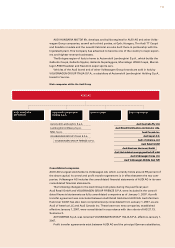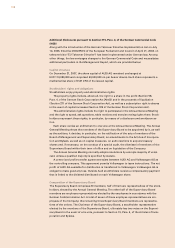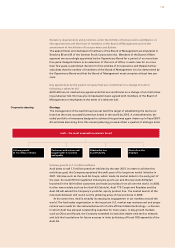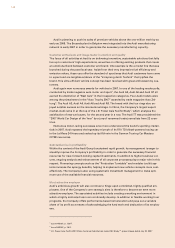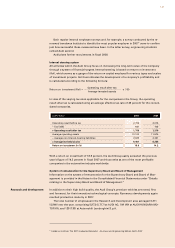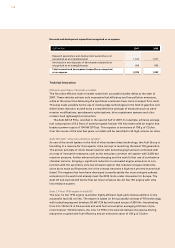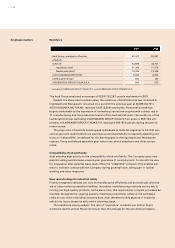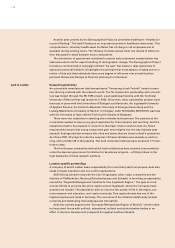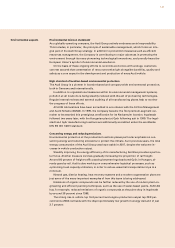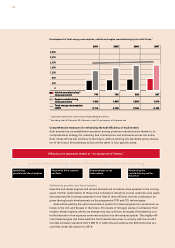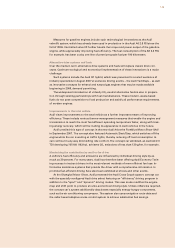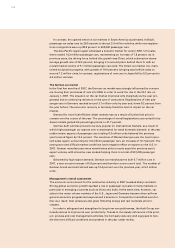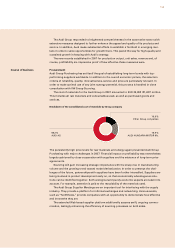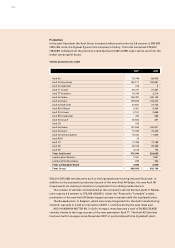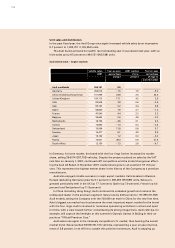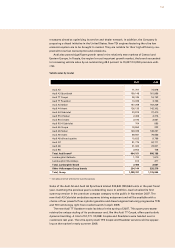Audi 2007 Annual Report Download - page 150
Download and view the complete annual report
Please find page 150 of the 2007 Audi annual report below. You can navigate through the pages in the report by either clicking on the pages listed below, or by using the keyword search tool below to find specific information within the annual report.
147
Environmental mission statement
As a globally operating company, the Audi Group actively embraces social responsibility.
This includes, in particular, the principle of sustainable management, which forms an inte-
gral part of the Audi Group strategy. In addition to prevention measures such as efficient
resources management, the Company is contributing to major advances in protecting the
environment through its many pioneering technological innovations, and proudly bears the
European Union’s symbol of environmental excellence.
On the basis of these ongoing efforts to reconcile economics with ecology, customers
can rest assured that conservation of resources ranks right alongside durability, quality and
safety as a core aspect in the development and production of every Audi vehicle.
High standard of location-based environmental protection
The Audi Group is a pioneer in location-based and company-wide environmental protection,
both in Germany and internationally.
In addition to organizational measures within its environmental management systems,
pollution at all locations is being steadily reduced with the aid of pioneering technologies.
Regular internal reviews and external auditing of all manufacturing plants help to monitor
the progress of these efforts.
All AUDI AG locations have been accredited in accordance with the EU Eco-Management
and Audit Scheme (EMAS). In 1995, the Company became the first premium-segment car-
maker to be awarded this prestigious certification for its Neckarsulm location. Ingolstadt
followed two years later, with the Hungarian plant at Győr following suit in 1999. The Ingol-
stadt and Győr manufacturing locations are additionally accredited under the worldwide
DIN EN ISO 14001 standard.
Conserving energy and reducing emissions
Environmental protection at the production locations places particular emphasis on con-
serving energy and reducing emissions to protect the climate. As in previous years, the total
energy consumption of the Audi Group was kept stable in 2007, despite the welcome in-
crease in vehicle production output.
Steadily improving the energy efficiency of its manufacturing facilities provides a particu-
lar focus. Another measure involves gradually increasing the proportion of rail freight.
Around 80 percent of freight traffic passing between Ingolstadt and Győr, in Hungary, al-
ready goes by rail. Audi is also working on comprehensive logistical processes, such as
optimizing truck capacity utilization, in order to reduce essential transportation trips to a
minimum.
Natural gas, district heating, heat recovery systems and a modern cogeneration plant are
just some of the many important examples of how this issue is being addressed.
Emissions of organic compounds can be further reduced by the use of modern plant en-
gineering and efficient painting techniques, such as the use of water-based paints. AUDI AG
has, for example, reduced emissions of organic compounds at the paint shop in Ingolstadt
by around 38 percent since 1998.
The strong rise in vehicle (up 16.4 percent) and engine production output (up 28.9 per-
cent) since 2004 contrasts with the disproportionately low growth in energy demand of just
3.7 percent:
Environmental aspects


